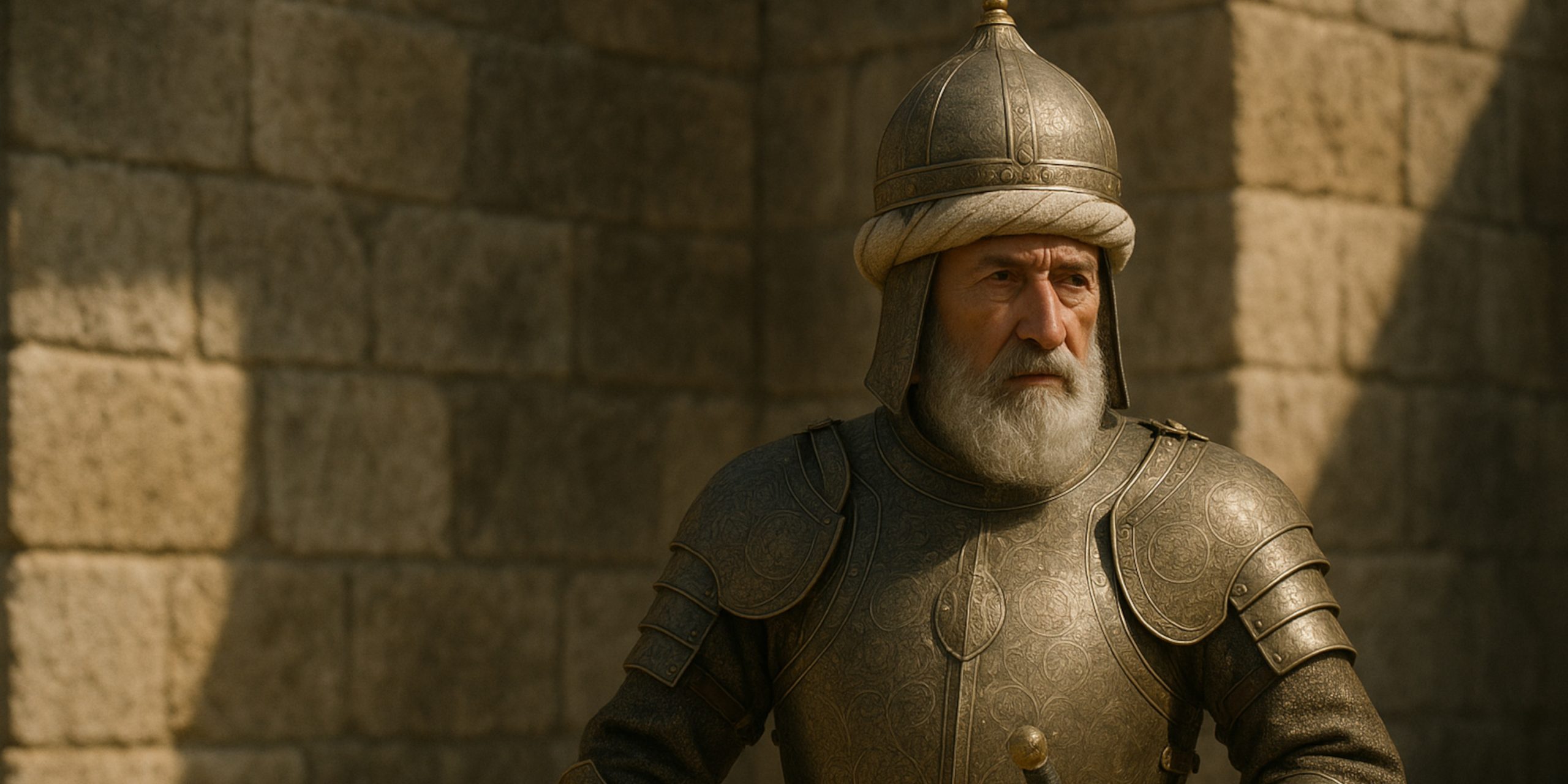
Suleiman I, known in the West as Suleiman the Magnificent and in the Islamic world as Kanuni (“the Lawgiver”), reigned as Sultan of the Ottoman Empire from 1520 to 1566. His rule marked the high point of Ottoman power, culture, and territorial reach. More than a conqueror, Suleiman was a reformer, poet, and patron of architecture, yet his military prowess defined the era.
Arms and Armour
Suleiman’s court invested heavily in the splendour and symbolism of martial gear. His personal armour, ceremonial weapons, and battlefield equipment reflected both Ottoman and broader Islamic artistic traditions.
- Armour: Suleiman is believed to have worn elaborately decorated mail and plate, often adorned with gold inlay and Quranic inscriptions. This ceremonial armour was designed to symbolise authority rather than function purely for protection.
- Swords: The kilij, a curved sabre suited to mounted warfare, was the preferred Ottoman blade. Many kilijs attributed to his reign display high-quality Damascus steel, ornate scabbards, and jewelled hilts.
- Bows and Firearms: Elite Janissaries and Sipahi cavalry used composite recurve bows with great efficiency. Suleiman’s campaigns also incorporated matchlock muskets and early artillery, particularly during sieges.
- Helmets and Shields: Helmets (miğfer) from his court often feature raised arabesques and inscriptions. Shields were typically round, of hide or steel, decorated with Islamic motifs.
Several of these items or their close contemporaries can be found in Istanbul’s Topkapi Palace Museum, the Military Museum (Askerî Müze), and in European collections such as the Kunsthistorisches Museum in Vienna.
Battles and Military Accumen
Suleiman was a commander of rare discipline and daring. He personally led 13 major campaigns, expanding the empire deeper into Europe, North Africa, and the Middle East.
Major Engagements:
- Battle of Mohács (1526): A crushing Ottoman victory over the Kingdom of Hungary. Suleiman’s forces routed the Hungarian army in under two hours. The aftermath left Central Europe exposed to Ottoman influence.
- Siege of Vienna (1529): Though unsuccessful, this campaign marked the furthest westward push of the Ottoman military machine. It shocked Europe and solidified Suleiman’s image as a formidable adversary.
- Conquest of Baghdad (1534): Part of a long campaign against the Safavid Empire. His army took the Persian capital, asserting Sunni dominance over Shi’a rivals.
- Naval Power: Under the admiral Hayreddin Barbarossa, the Ottomans established maritime supremacy across the eastern Mediterranean, defeating European fleets at battles like Preveza (1538).
Suleiman’s campaigns were marked by their scale and logistical complexity. He maintained discipline within his ranks and combined traditional Ottoman tactics with innovations in siegecraft and firearm use. His ability to integrate diverse ethnic and religious troops into a cohesive fighting force was central to his success.
Legacy and Reform
While his military achievements were formidable, Suleiman was equally renowned for reorganising the empire’s legal system. His reforms unified civil and religious law, codifying existing practices and improving justice administration. This earned him his eastern title, “the Lawgiver”.
The Sultan presided over a court that encouraged poetry, calligraphy, and architecture. With the architect Mimar Sinan, he transformed Istanbul’s skyline with buildings like the Süleymaniye Mosque, a statement of religious and imperial authority.
Where to See Artefacts from His Reign
- Topkapi Palace (Istanbul): Houses Suleiman’s robes, writing implements, and alleged personal weapons. The Treasury holds several ornate swords and ceremonial objects from his court.
- Süleymaniye Mosque Complex: Includes his mausoleum, offering insight into Ottoman funerary architecture and the high craftsmanship of the era.
- British Museum and Louvre: Both hold Ottoman artefacts from the 16th century, including ceramics, armour, and manuscripts linked to his reign.
- Hungarian National Museum: Displays recovered battlefield items from Mohács and subsequent conflicts.
Latest Archaeological Findings
- Mohács Battlefield Investigations: Ongoing excavations have revealed burial pits and military equipment consistent with Ottoman and Hungarian troops. Forensic work has helped reconstruct the speed and brutality of the battle.
- Urban Studies in Istanbul: Excavations beneath the city continue to uncover layers from Suleiman’s expansion, including bathhouses and military barracks that supported his campaigns.
- Document Recovery: Ottoman archives have yielded letters between Suleiman and European leaders, giving clearer views of diplomatic strategies. Some contain his seal and personal handwriting.
Suleiman the Magnificent was a statesman, warrior, poet, and builder of empires. His reign fused military ambition with legal and cultural achievement on a scale few rulers have matched. His legacy is etched not just in the territories he conquered, but in the institutions and monuments that outlived him.
Watch the documentary:



